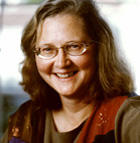Prof. Elizabeth H. Blackburn was awarded the Dr A.H. Heineken Prize for Medicine 2004 for identifying the structure of chromosome ends (telomeres) and discovering the enzyme telomerase.
Elizabeth Blackburn has been given the sobriquet ‘Queen of the Telomeres’ because virtually everything we know about the form and function of the ends of chromosomes began with her. Before Blackburn, all we knew was that telomeres (from the Greek for ‘end’ and ‘part’) became shorter with each cell division. They are hence regarded as a kind of clock which is in any event partly responsible for the natural ageing process. Since Blackburn proved that telomeres have a unique structure that protects genetic material, however, they have also been compared to the ends of shoelaces: they are a marker that ensures that a chromosome does not ‘unravel’. It was also Elizabeth Blackburn who identified what telomeres are made of: a short, simple DNA sequence repeated over and over again, the sequence being slightly different in each organism.
Blackburn’s research group made the spectacular discovery that, although telomeres become shorter during cell division – to the point that cells are no longer capable of dividing – they in fact also replicate, and do so in a way entirely different from the rest of the chromosomal DNA. Ordinary DNA makes an exact copy of itself using the enzyme DNA polymerase; a telomere, on the other hand, copies an RNA sequence, a process known as reverse transcription. It does so using an enzyme baptised telomerase, which has the effect of lengthening it. Telomerase has been found in some specialised cells and in stem cells. These cells are capable of ‘supplementing’ their telomeres and ‘rejuvenating’ themselves.
But although telomerase has been found to be crucial to normal cell growth, it also plays a role in the uncontrolled, menacing type of cell growth. Eighty to ninety percent of all cancer cells have lengthened telomeres and contain a relatively large quantity of telomerase. Blackburn has even said that cancer cells are ‘addicted to telomerase’, and found that reducing the quantity of telomerase is enough to kill off cancer cells within a few days. Is telomerase the source of eternal youth or is it a murder weapon? Researchers are in any event already working on new cancer medications based on Blackburn’s discoveries.
Further reading
Szostak, J.W., Blackburn, E.H., Cloning yeast telomeres on linear plasmid vectors, Cell 29: 245-55, 1982
Greider, C.W., Blackburn E.H., Identification of a specific telomere terminal transferase activity in Tetrahymena extracts, Cell 43: 405-413, 1985
Yu, G.-L., Bradley, J.D., Attardi, L.D., Blackburn, E.H., In vivo alteration of telomere sequences and senescence caused by mutated Tetrahymenatelomerase RNAs, Nature 344: 126-132, 1990
Blackburn, E.H., Telomere states and cell fates, Nature 408: 53-56, 2000
Biography
Elizabeth H. Blackburn was born in Tasmania, Australia, in 1948. She studied biochemistry at the University of Melbourne and received her Ph.D. in molecular biology from Cambridge in the United Kingdom in 1975. She then moved to the United States, her present home. She became a U.S. citizen in September 2003.
From 1975 to 1977, Blackburn did her post-doctoral work at Yale University, where her research included the DNA structure of the telomeres of the Tetrahymena, a single-cell pond-dweller (and parasite). She continued her career on the West Coast, joining the Department of Molecular Biology at the University of California in San Francisco in 1993. She is currently a professor in the Department of Biochemistry and Biophysics, where she has her laboratory. Blackburn has been the recipient of many awards and marks of honour, including an honorary doctorate from Yale University, the California Scientist of the Year Award (1999) and the General Motors Cancer Research Foundation Alfred P. Sloane Award (2001). In 2009 she won the Nobel Prize in Physiology or Medicine, together with Carol W. Greider and Jack W. Szostak. She has taken on many executive positions (for example as the president of the American Society for Cell Biology) and has an even longer list of lectures, articles and contributions credited to her name.
After accepting President Bush’s invitation to join his Council on Bioethics in 2001, Blackburn regularly took part in the public debate on therapeutic cloning and stem cell research, which she – unlike the Bush administration – advocates. The unexpected news that the White House had not renewed her membership of the Council led to protests in the foreign and American media and to considerable discussion of the role of politics in science.
Laudatio
— English
Article
— Interview with Elizabeth Blackburn in Akademie Nieuws (Dutch)
Video
Video interview with Elizabeth Blackburn, laureate of the Dr A.H. Heineken Prize for Medicine 2004
